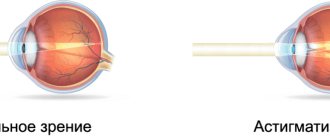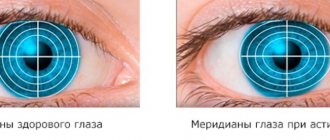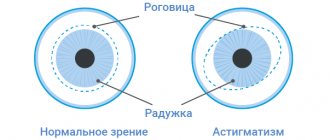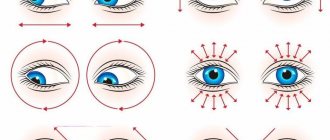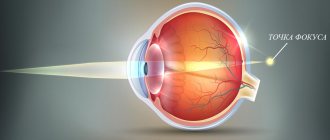The organ of vision is an optical system that includes the cornea, the aqueous humor of the anterior chamber, the lens and the vitreous body.
The refraction of the eye is the refractive power, which is indicated in diopters.
The clarity of the resulting image depends on the ability of the refractive power to focus rays on the retina.
In ophthalmology, there are two types of refraction: commensurate, when the rays are focused on the retina, and disproportionate. The latter includes such anomalies as myopia, farsightedness and astigmatism. The prevalence of refractive errors among the population is steadily increasing and leads to decreased visual acuity and deterioration in quality of life.
What is astigmatism
Astigmatism is characterized by unequal refraction of rays in different directions, associated with different curvature of the spherical surface of the cornea. With this disorder, different types of refraction or different degrees of the same type of refraction are combined in one eye.
The cause of the disease is a violation of the sphericity of the lens or cornea. With astigmatism, two main meridians are distinguished: mutually perpendicular planes with the greatest and least refractive power.
The degree of the disease is determined by the difference in refraction in the main meridians: if the refraction is constant along both conventional lines, they speak of correct astigmatism (mostly congenital disorders). Irregular astigmatism is characterized by changes in refraction at different points of the meridian. This occurs due to trauma to the eye, changes in the location and shape of the lens.
Depending on the relative position of the two conventional lines, astigmatism is distinguished as direct, reverse, and with oblique axes.
We recommend reading: Reverse and direct astigmatism
Accommodation of the eye cannot cope with the phenomena of astigmatism, therefore special lenses are used to correct refractive errors of the cornea.
Symptoms of myopia, farsightedness and astigmatism
In principle, we have already mentioned the main signs of the appearance of the described eye diseases.
Thus, the main symptoms of myopia are deterioration of vision at a great distance, the main symptoms of farsightedness are blurred perception of close objects, and the symptoms of astigmatism are characterized by “floating” changeable vision. Most often, we notice deterioration in vision by accident, when we cannot read a book without glasses or, on the contrary, we have difficulty distinguishing the number of an approaching vehicle. At this stage, we can say that you have an eye disease that requires treatment. At the same time, it is believed that some deviations from the norm are quite acceptable. For example, astigmatism, in which the differences in refractive power at different points are up to one diopter, is considered normal.
You are quite capable of determining your vision yourself using special tests with tables. Therefore, we will dwell on vision diagnostics separately.
What is myopia
Nearsightedness (or myopia) is a disorder in which the ciliary muscle is relaxed and light rays from a distant object are focused in front of the retina.
The disorder develops due to two reasons:
- excessively long eyeball;
- greater refraction of the lens.
There are no mechanisms by which the organ of vision could reduce the refraction of the lens with a completely relaxed ciliary muscle. But when the object is at close range, the accommodation mechanism is triggered and the image becomes clear. However, constant tension in this case leads to the formation of muscle asthenopia (fatigue) and impaired binocular vision (with the development of divergent strabismus).
According to the time of formation of myopia, a distinction is made between congenital and acquired impairment, and according to its course - non-progressive and progressive myopia. Congenital anomalies usually tend to progress.
Thus, a person with myopia only has difficulty viewing distant objects. To see well at a distance, nearsighted people should wear glasses with biconcave lenses.
Diagnosis of refractive eye problems
The simplest and most common way to determine vision is tables . As you know, such tables present rows of letters of different sizes and rings with cuts, which are used to test the eyesight of people who do not know the alphabet. This test, when performed correctly, allows you to determine myopia or farsightedness in each eye separately.
All other diagnostic methods are somewhat more complicated. Instead of changing the size of the letters (that is, the image), in some cases they select the correct additional lens, which “returns” the focus to the retina. Ophthalmologists resort to this method in optical salons when selecting suitable glasses.
The remaining types of examinations “study” the elements of the eye, that is, they determine the curvature of the cornea, examine the pupil using precise rulers in a dilated state, and others.
What are the differences between pathologies?
The same elements of the optical system of the eye are involved in these refractive errors, but the principles of development of the disorders and their manifestations are different. This is the main difference between the two diseases. Each of them has its own clinical picture if the diseases are diagnosed in isolation from each other.
Astigmatism has a congenital or acquired nature and is characterized by a change in the normal shape of the cornea or lens. As a result, light rays are refracted incorrectly, the focus points are shifted and the retina captures a distorted image. The consequence is that the eye sees objects blurry.
With myopia, objects are focused in front of the retina, and a person sees blurry objects only in the distance. Myopia combined with astigmatism complicates treatment.
So, the main difference between the two disorders is that with myopia a person sees objects blurry only in the distance, and with astigmatism - at any distance.
There are also different approaches to correcting the disease. For myopia, diverging (negative) lenses are recommended, for simple astigmatism - cylindrical ones.
Complex and mixed astigmatism is corrected using lenses that combine cylindrical and spherical components.
It should be borne in mind that wearing glasses in both cases does not eliminate the cause, therefore, if long-term wearing of glasses does not give a positive effect, they resort to surgical methods of treatment. For myopia, the operation can be performed at any age, and for astigmatism - only for adults.
Prevention of myopia, farsightedness and astigmatism
Myopia, farsightedness and astigmatism in many cases could be avoided if the patient followed certain simple rules. Their essence comes down to leveling actions that threaten changes in the optical instruments of the eye, and performing exercises that strengthen these instruments.
These exercises are quite simple and widely known: quickly switching focus from close to distant objects, frequent blinking, eye rotation, switching from the monitor or TV every 20 minutes to calm, non-blinking objects.
If you add control over your actions to regular exercises, that is, always read in the right lighting and without lying down, do not watch TV continuously for hours, do not abuse bad habits, and protect your eyes from damage, then problems with refraction can be avoided. Believe me, it’s worth it, because in addition to deteriorating vision, a consequence of myopia can be cataracts , and this disease is even more dangerous.
Useful video
More information about myopia and astigmatism can be found in the video.
Author's rating
Author of the article
Alexandrova O.M.
Articles written
2029
about the author
Was the article helpful?
Rate the material on a five-point scale!
( 1 ratings, average: 5.00 out of 5)
If you have any questions or want to share your opinion or experience, write a comment below.
Vision problems in children
The modern world has a detrimental effect on the condition of the eyes. This is especially true for young children and teenagers. Myopia and farsightedness are quite common in children. Farsightedness is considered normal for children and by the age of 11, as a rule, everything gets better, but there are cases when the problem does not go away and leads to serious visual impairment.
There are cases when children do not complain about vision problems and farsightedness occurs in a latent form. This can lead to a general deterioration in the child’s health: irritability, headaches, poor health. This problem can be solved only after proper examination and treatment.
The situation is different with myopia. Since this problem has many factors that cause eye disease: heredity, congenital pathologies, prematurity, visual stress, poor nutrition, various infections.
The first examination by a doctor is performed at the age of 3 months, during which the ophthalmologist looks at the size and shape of the eyeballs, how the baby reacts and focuses his gaze on bright objects.
General measures to prevent myopia
Creating comfortable conditions for study or work. These preventative measures apply to both children and adults. The workplace should be organized in such a way that daylight falls on the left for right-handed people. The chair should have a rigid back and not be too high or low relative to the table, otherwise constant tension in the neck muscles and changes in the spine can lead to problems with blood circulation in the vertebral arteries, which negatively affects vision function (and existing myopia can progress). The source of artificial light is also located on the left for right-handed people; the light should not be too bright and not too dim.
Reasonable distribution of visual loads throughout the day. To avoid myopia, it is necessary to rest your vision and alternate working at the computer and studying with books with “physical education” or eye gymnastics. Simple exercises to prevent eye fatigue with alternating looks at a point in the distance and a point near (for example, a tree outside the window and a point on the window glass) will help train the accommodative apparatus of the eye and reduce the phenomena of asthenopia and false myopia.
Balanced diet. A sufficient amount of vitamins (A, group B, C), polyunsaturated fatty acids, protein, and minerals is necessary for the normal functioning of the organ of vision. Therefore, prevention of myopia involves revising the diet in favor of natural, “healthy” foods.
Regular physical activity. This component of myopia prevention should be given due attention from childhood. Regular sports, team games, dancing and other activities contribute to the harmonious development of the body, including the nervous system and the organ of vision. Physical activity stimulates blood flow and microcirculation in all tissues and organs and allows you to avoid oxygen starvation, which is an excellent prevention of decreased vision, including myopia.
Contraindications for vision restoration
If there are practically no contraindications for wearing lenses and glasses, then in cases of laser correction you should know when it should not be done.
- If a woman is pregnant.
- During lactation.
- Diabetes.
- Glaucoma or cataracts.
- If the fundus of the eye has irreversible changes.
- Inflammatory processes in the body.
We can say that myopia and farsightedness can be cured. Treatment must be timely, since advanced forms are difficult to correct.
Prevention of visual impairment in a baby: what an expectant mother needs to know
Prevention of myopia begins in the antenatal period. Taking folic acid in the first weeks of pregnancy helps prevent the development of abnormalities in the structure of the neural tube. The nervous system is closely connected with the organ of vision, so you should not neglect your doctor’s recommendations about taking folic acid, multivitamins and other medications. It is necessary to exclude exposure to harmful factors: tobacco smoke, alcohol, x-rays, etc. The described preventive measures will help increase the chances of the future baby having healthy vision.
Therapeutic cinema
In general, myopia, despite the fact that this disease is progressive, is not the worst, ophthalmologists say. Even with a high degree of it, at 17–18 years old, when the eyeball stops growing, you can do laser correction and return 100% visual acuity. But you can often do without a scalpel.
One of the most effective methods of conservative treatment is video-computer auto-training, based on the fact that the brain “learns new reflexes” using the biofeedback method when watching videos. Children really like this treatment - the child sits in front of the screen and watches a cartoon: special sensors controlled by a computer monitor the progress of the training. As soon as your eyes start to get lazy, the screen goes blank. So, if you want to watch a movie, work hard!
Correction
Certain vision problems can be solved quite simply in a timely manner. Regardless of whether myopia or farsightedness is a hereditary or acquired disease, it can be cured with laser correction. This method has proven itself as an effective treatment for such problems in many countries around the world. After correction, people get rid of the need to use glasses or contacts.
How is myopia and farsightedness corrected? It should be noted here that each individual person has their own method, since each of us has unique eyes, just like our fingerprints.
This procedure is quick and very safe. After the ophthalmologist conducts a series of studies and tests, he proceeds with the operation, after which the patient’s vision is restored. The correction is performed using local anesthesia, its duration is about 20 minutes, but all manipulations associated with the laser take no more than a minute.
Hospitalization after the operation is not required. It is enough to stay in the hospital for a few hours. The result will become noticeable the very next day, and complete restoration of vision occurs after one week.
Correction does not contribute to vision deterioration in the long term; on the contrary, this process is irreversible and remains forever.


